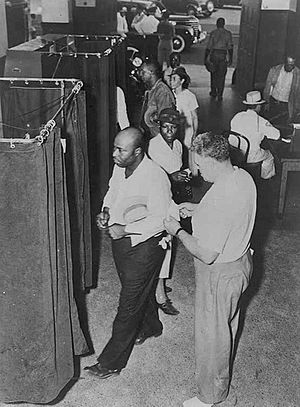Voter suppression facts for kids
Voter suppression is when people try to stop or make it harder for certain groups of citizens to vote in an election. It's different from regular political campaigns, which try to convince people to vote for a certain person or idea. Instead, voter suppression tries to win by making sure fewer people from a specific group vote. This can be seen as an unfair way to influence elections and goes against the idea of a fair democracy.

The ways people try to suppress votes can range from making voting seem too difficult or tiring, to even scaring or hurting people who want to vote.
Contents
What is Voter Suppression?
Voter suppression is a plan used to change the result of an election. It works by making it harder for certain people to vote. This is different from a normal campaign. A campaign tries to get people to vote for someone by changing their minds. It also tries to get people who don't usually vote to participate.
Voter suppression, however, tries to win by lowering the number of votes from specific groups. It's a tactic that goes against the idea of a fair and open democracy. It is often linked to authoritarianism, where leaders have a lot of power and don't want everyone to have a say.
How Does Voter Suppression Work?
There are many ways that voter suppression can happen. These methods can make voting harder or even scary for some people.
Making Voting Difficult
Some tactics make voting seem too much trouble. This can cause "voter fatigue." People might get tired or frustrated and decide not to vote.
Rules and Requirements
One way is to change voting rules. For example, new rules might ask for specific types of photo IDs. If many people don't have these IDs, they might not be able to vote. Another example is making it harder to register to vote. This can stop new voters from joining.
Polling Place Changes
Sometimes, the number of places where people can vote (called polling places) is reduced. This can lead to very long lines. People might have to wait for many hours. If a polling place is moved far away, it can be hard for people without cars to get there. These changes can make voting very inconvenient.
Limiting Voting Times
Reducing the number of days or hours for voting can also suppress votes. If people work long hours, they might not have time to vote if the polling places are only open during work hours. Early voting or weekend voting options can be removed, making it harder for busy people to cast their ballots.
Scaring or Tricking Voters
Other methods of voter suppression are more direct and harmful.
Intimidation
Some people try to scare voters away from the polls. This is called intimidation. They might stand near polling places and act in a threatening way. They might spread false rumors about who can vote. This can make people afraid to go and vote.
False Information
Another tactic is spreading wrong information. People might be told the wrong date for the election. They might be told their polling place has moved when it hasn't. Sometimes, false information is spread about who is allowed to vote. This can confuse voters and stop them from showing up.
Challenging Voters
Sometimes, people try to challenge a voter's right to vote at the polling place. They might claim a voter is not eligible without good reason. This can cause delays and make voting a stressful experience. It can also discourage others from trying to vote.
Why is Voter Suppression a Problem?
Voter suppression goes against the idea of equal voting rights. In a democracy, every citizen should have the chance to vote easily and fairly. When certain groups are stopped from voting, their voices are not heard. This can lead to unfair election results. It means that the government might not truly represent all the people.
It is important for everyone to have the chance to vote. This helps make sure that leaders are chosen by all citizens. It also helps make sure that the government makes decisions that are good for everyone.
See also
 In Spanish: Supresión del votante para niños
In Spanish: Supresión del votante para niños
- Authoritarianism
- Hybrid regime
- Democratic backsliding
- Electoral fraud
- Gerrymandering
- Unfair election
- Vote equality
- Voter caging

